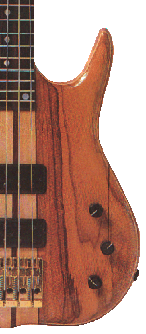
Making Your First Guitar
A Tutorial
General Considerations
Before you start, envision what you would want to own after the project is through. You will only be limited by your talent and your imagination. If you don't already have an instrument in mind, take a walk through some music stores and check out the various designs and shapes. Your instrument should be pleasing to your eye as well as being functional. Try out some of the various products available to see how they feel to you. How does the neck feel? And, when you find one you like, note the shape of the neck. Is it "U" shaped or somewhat "V" shaped or flattened on the bottom? How does the "center of gravity" feel? Does the weight of the neck force the neck to the floor when you balance the guitar on your knee or have it on a strap? Does the string spacing feel awkward, making you reach for the next string? Or, crammed together so that you find it difficult to pluck the notes? Find a string spacing you are comfortable with allowing you to reach adjacent strings with ease. Make notes of features you like and those you don't.
Check through books at the stores or library and find a design you like. Trade magazines such as Bass Player or Guitar Player usually highlight some designs in each issue. Check out the back issues and the annual "Buyer's Guides" to compare different designs and often reviews of the instrument itself.
If you have decided on building a clone of an existing instrument, you can borrow a friend's instrument and take measurements directly from it and even trace the outline of the body. If you get yourself friendly with a store owner, he or she may allow you to do the same with one of their instruments, or you can just say you are taking some measurements for comparison shopping before you buy, or "want to make sure it will fit in the case you already own". Be creative!
From a book or magazine, you find out one measurement and calculate all the others from it. One measurement always stated should be the scale length of the instrument and from this piece of knowledge, put your high school math to good use and calculate the actual size from the drawing. You might consider making a photocopy of the picture and enlarge it repeatedly until it approaches actual size. That can now serve as a template for the shape and the size can be nudged up or down a bit to the desired dimensions by following the photocopy.
Those with computer skills can use various drawing or CAD programs to design your instrument and reproduce it to a plotter or print it out sequentially on a conventional printer.
If you have decided to use your own custom design, some of the above tips can still be used. Moderation is the best advice for custom design. Instrument bodies have been made toresemble "Jack Daniels" liquor bottles, toilet seats and the United States map, just to mention a few. These are fine for promotion, but will feel very awkward after only a few minutes of playing. Stay away from unusually long "horns", sharp edges, sudden changes in contour, etc. The reason most guitars and basses look as they do is because over the years, these designs have endured due to their comfort and playability.
By this time, you should also know whether your instrument's neck will be bolted on, or through the body and will build correspondingly. This again is personal preference from feel, looks and sound. Both designs have pluses and minuses in their ease of construction.
One final consideration is scale length, which is defined as the distance from the fingerboard edge of the nut to the bridge. The twelfth fret, or first harmonic, of the strings theoretically lies at the halfway point of this distance. I say, "theoretically", as the mass of the strings becomes involved and there is usually a need for compensation, which will be discussed later under "Setups" (which is still to be written).
Many early basses, such as the Gibson EBO, had what is referred to as a "short scale" at 32 inches. This was certainly easier for musicians with small hands, but often had a muddier tone. Long scale basses are considered to be 34 inches or greater and many of the instruments on the current market are 34 inches. Five string basses with a Low B string benefit from an even greater scale length of, say, 35 inches, as this extra inch preserves more of the dynamics of this string and it doesn't sound muted or muddy when played. Scale length is derived from a mathematical formula and any scale length whatsoever can be calculated. Rather than getting you to do all the mathematics, I'm including here a link to a fret Guitar Fret Calculator which, when you tell it what scale length you wish, will calculate the positions of all the remaining frets. An alternative might be to take very accurate readings from a finished instrument, but errors can occur and usually will multiply out by the end of your fretboard.
Summary: At this point, you should know what you intend to build and have some measurements written down and characteristics in mind. The next step is to gather all this information together and present it as a drawing or blueprint.